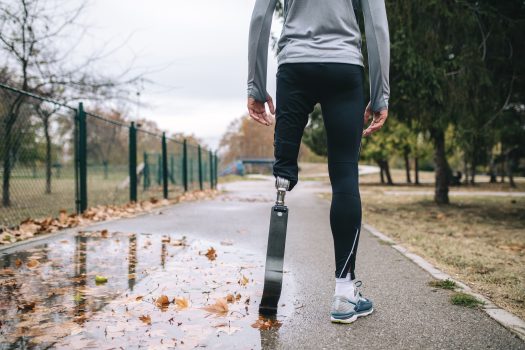 In Australia, someone will lose a limb due to amputation every 30 minutes, according to peak body Limbs 4 Life. People lose limbs as a result of diseases like diabetes or cancer, while others face limb loss as a result of accidents or infection.
In Australia, someone will lose a limb due to amputation every 30 minutes, according to peak body Limbs 4 Life. People lose limbs as a result of diseases like diabetes or cancer, while others face limb loss as a result of accidents or infection.
Jack*, 42, lives in western Sydney and lost his leg below the knee following a workplace accident that led to a severe infection. As the infection got worse, doctors were forced to remove the affected area to prevent the infection from spreading to other parts of his body.
Following his transtibial or below-knee amputation, Jack was fitted with a prosthesis, or artificial limb. However, like many people he was unable to stand on his prosthesis without significant pain. With limited ability to walk, he relied mainly on his manual wheelchair to move around his home and community.
This is where occupational therapy for amputees comes in.
Support from a team of therapists
As part of his NDIS plan, Jack’s goal was to be able to run again with his prosthetic. He decided to register with Ability Action Australia, which provides a multidisciplinary allied health service. This means Jack can access a variety of NDIS therapy services through one single service provider, simplifying his entire NDIS experience.
Jack has primarily received treatment from one of our exercise physiologists, with additional support from our occupational therapy team and NDIS physiotherapists, who have collaborated to support as many of his needs as possible.
Senior Exercise Physiologist George Paneras structured a very simple but effective strengthening program involving exercises including step ups, hip drives, and weighted squats to assist in achieving his goal of running with his prosthetic.
“During the initial assessment I observed that he had glute and hamstring weakness which led to imbalance on his prosthetic leg,” George says.
“I then developed an exercise program with strengthening exercises that challenged these areas and Jack worked on these diligently. This increased his strength and actually improved his weight shifting, which decreased the pain he was getting on his prosthetic.”
Jack’s orthotist was also an integral part in ensuring his prosthetic was appropriate and safe, and that the prosthetic socket that joins the residual limb to the prosthesis was a good fit, as a poorly fitting socket can be uncomfortable and painful to wear.
Stronger and more confident
George says input from these services have all combined to increase Jack’s capacity. He is now walking and moving about independently with his prosthetic without the need of any aids.
With the exercise program, the first step was to achieve the goal of running a few metres and then over time his capacity and confidence continued to improve. He can now run up to 150m to 200m at a time, before needing a rest. He runs up and down his driveway and sometimes down at the park.
“He’s now running and feels much fitter and stronger. An outstanding achievement for him as this improves his overall confidence and his motivation to keep improving,’ George says.
“His aerobic capacity still needs some work which is the next phase of our exercise plan. By getting him involved in a structured and goal-oriented program this has improved his confidence massively.
“Now the sky is the limit and he’s confident he can improve further and be able to run for several minutes without needing a rest.”
Occupational therapy for amputees
Speak to us today about how our tailored and safe exercise rehabilitation programs can help you effectively self-manage your condition. Call our friendly concierge service on 1800 238 958 or complete the request contact form and we’ll contact you at a time that suits you best.
*name changed for privacy reasons

